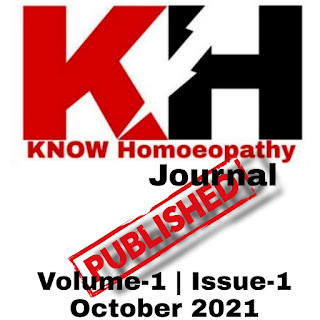KNOW Homoeopathy Journal
Volume-1 | Issue-1 | October-2021
Title: Implications of Physiological Action of Calendula Officinalis to Understand Its Guiding Symptoms
2. Research Officer (Homoeopathy)/Scientist-1, Dr DP Rastogi Central Research Institute of Homoeopathy, NOIDA, Uttar Pradesh, India.

Click Here to Download Full Paper - PDF File
CLICK HERE TO SEE - EDITORIAL BOARD DETAILS
CLICK HERE TO SEE - PUBLISHER DETAILS
CLICK HERE TO READ - COPYRIGHT POLICY
CLICK HERE TO READ - DISCLAIMER
KNOW Homoeopathy Journal
Volume-1 | Issue-1 | October-2021
ABSTRACT-
Calendula officinalis(Calendula), belonging to the family of Asteraceae commonly known as Pot-marigold is used as sudorific, blood refiner, blood suger reducer, and also used as anti-inflammatory.Currently, this plant is used in registered homeopathic drugs. Its more and orange kinds are favorable medicinally, since they contain a lot of effective components.[1]
1.BACKGROUND-Calendula, often called Mary-bud or Pot-marigold, is one of the first flowers to be grown. The plant was originally documented in the third century BC, and it was a popular fixture in French gardens in the fifth century. The latin phrase for the first day of the month is calendae. The plant has been cultivated in England since the 1200s. One of the numerous traditional legends that enhance the history of this plant is about a lovely, golden-haired kid called Mary-gold who spent all of her time admiring the sun until one day she disappeared and was never recovered. In the area where she used to sit, a little sun-like flower bloomed. According to the child's friend, the small flower was really a Mary-gold that had been converted into a flower. By the 1800s, doctors had learned that using the plant as a poultice may stop bleeding. Around the period of the civil war, most physicians carried dried calendula petals in their medical kits.
2.HISTORY-
2.1.SOURCE
– Flower (Pot marigold as flowers used in catholic events)
3.DISCUSSION
3.1.PHYSIOLOGICAL ACTION OF CALENDULA OFFICINALIS[2]
The flower is widely used as a medical plant because of its antibacterial, antifungal, and anti-inflammatory characteristics, which make it an effective therapeutic ingredient.
· Calendula is largely regarded as a wound healer because of its calming propertiesCalendula petals are a must-have in every medical cabinet because, despite being a delicate plant, they have extraordinarily potent healing qualities. Among other wounds, it may aid with bug bites, bruises, blisters, cuts, and cold sores.
·
Assists with Digestive
and Immune System-Calendula has been shown to boost the immune system's capacity to fight illness. Calendula's antibacterial capabilities are most likely to blame, since it slows or kills illness to prevent it from spreading. It may be able to assist you get rid of that persistent cough or congestion due to its antibacterial properties.
·
Hydrates and Nourishes
Dry Skin-Calendula is a flower that may be used to cure a range of skin problems that cause dry, itchy, or irritated skin by increasing the production of collagen, a protein that is essential for healthy skin.
·
Slows Development of
Wrinkles-Antioxidants and anti-inflammatory components found in calendula have been demonstrated to protect human skin cells from oxidative damage.
·
Reducing Scarring-Calendula promotes blood flow to the region, supporting a speedy and healthy infection-free healing process as well as the formation of healthy new tissue.
· According to Dr William boericke;
A most remarkable healing agent,applied locally.Useful for open wounds,parts that will not heal,ulcers,etc.Promotes healthy granulations and rapid healing by first intention. Constitutional tendency to erysipelas.Superficial burns and scald.
Excessively painful, open,torn,cut,lacerated,ragged,or suppurating wounds.Prevents pus.Hemorrhages ,in scalp wounds or after drawing teeth ,etc.
It restores the vitality of injured parts ,and acts as an impregnable barrier to infection and germs.It prevents suppurations where suppuration should be prevented, and it brings on healing with wonderful promitude.It is suitable to all the cases of injury where the skin is broken and where the soft parts have been lacerated.After surgical operations,it promotes healthy granulation and arrests gangrene.It can be used both inernally and externally ,and it is an excellent hemostatic.
Calendula is to be thought of when the injury causes a torn or ragged wound ,possibly with loss of substance .Calendula removes the inflammatory condition of the part ,and so permits of healthy granulations.
KNOW Homoeopathy Journal
Volume-1 | Issue-1 | October-2021



